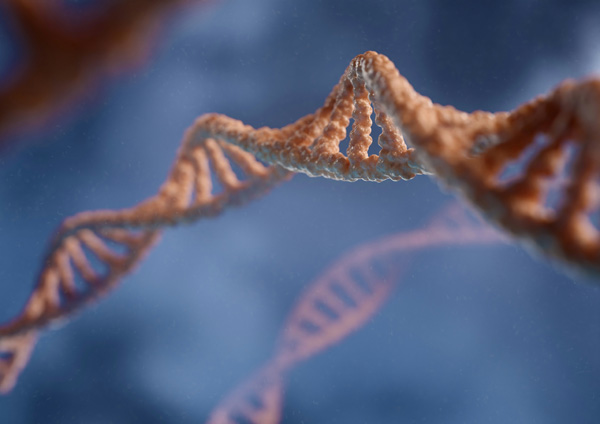Compact “gene scissor” enables effective genome editing

[Illustration of gene, Photo credit to Unsplash]
Researchers at the University of Zurich have made significant improvements to a smaller gene-editing tool called TnpB, boosting its ability to perform genome editing more effectively.
This tool is related to the widely used CRISPR-Cas system, a technology employed broadly in research and medicine to edit, insert, delete, or regulate genes in organisms.
This tool could play an important role in treating genetic disorders like high cholesterol.
TnpB originates from a tough bacterium known for surviving extreme conditions.
Despite its great potential, it hasn’t been very effective at editing DNA—until now.
Under the leadership of researcher Gerald Schwank, researchers have made TnpB much more efficient, boosting its DNA editing ability by more than four times.
The researchers achieved this through two critical modifications: improving TnpB’s ability to reach the cell nucleus (where DNA lives) and expanding the range of DNA sequences it can target.
Due to these advancements, TnpB can now edit DNA with impressive efficiency—up to 75.3% in mouse livers and 65.9% in mouse brains after recent testing.
One of the most promising applications of this improved tool is in treating familial hypercholesterolemia, a genetic condition that leads to high cholesterol and affects around 31 million people worldwide.
In tests, the researchers successfully edited a gene that controls cholesterol levels, resulting in nearly an 80% reduction in cholesterol in treated mice.
The size of TnpB is a standout feature.
Unlike larger CRISPR-Cas systems that need multiple virus particles for delivery, TnpB can fit into a single virus particle.
This makes delivery into cells easier, which could lead to better treatments.
As researchers continue to refine this innovative approach, there’s real hope that it could lead to effective treatments for people struggling with high cholesterol.
These advancements brighten the future of genetic medicine, offering new possibilities for tackling important health issues.
However, in an interview with Ms. Lee, my high school biology teacher, pointed out these advancements bring about complex ethical and technical challenges.
For instance, while TnpB’s smaller size allows it to be delivered efficiently into cells, it doesn’t eliminate the inherent risk of unintended DNA cuts.
Similar to the CRISPR-Cas9 system, TnpB may introduce off-target effects, potentially disrupting essential genes responsible for functions like tumor suppression.
Such errors, while rare, highlight the need for rigorous testing and precision in gene-editing applications.
Beyond medical treatments, gene-editing technology has also been explored in agriculture.
In this interview, Ms. Lee explained that scientists often employ “germ-line editing” in livestock, enabling genetic modifications to pass to future generations.
While this method can be effective for certain traits, it raises ethical concerns due to the risk of unforeseen health issues in the animals and potential effects on human consumers.
This risk has led to restrictions on germ-line editing in humans, with the notable exception of the controversial case involving “CRISPR babies” in China.
The incident has sparked debate on the ethical boundaries of gene editing in human reproduction.
Ms. Lee also discusses the contentious concept of “designer babies.”
The term, which emerged in 2004, refers to a future where genetic modifications could control or enhance specific traits in embryos.
This raises ethical questions about whether gene editing should be limited to disease treatment or also applied to non-medical traits, such as intelligence or physical attributes.
Ms. Lee expressed concern, suggesting that gene editing in humans should focus on therapeutic, non-inheritable modifications that benefit individuals without affecting future generations.
She advocates for somatic cell editing, where changes are limited to the person receiving treatment and are not genetically passed down.
As Ms. Lee highlighted, the rapid progress in genetics also requires a degree of humility.
Despite remarkable advancements, our understanding of genetics still remains incomplete.
Parts of mRNA once dismissed as “junk DNA” are now recognized as having essential roles, underscoring how much remains unknown.
This humility toward the complexity of genetic information, she suggests, is essential as scientists push forward in the field of genetic medicine.
In conclusion, the development of TnpB and similar tools could pave the way for effective treatments for conditions like familial hypercholesterolemia and other genetic disorders.
However, as Ms. Lee’s comments make clear, the potential of such powerful technology must be met with a cautious approach, ensuring that our reach into the genome aligns with responsible, ethical practices that respect the natural boundaries of life.

- Hyunseo Lee / Grade 12
- Global Vision Christian School

![THE HERALD STUDENT REPORTERS [US]](/assets/images/logo_student_us.png)
![THE HERALD STUDENT REPORTERS [Canada]](/assets/images/logo_student_ca.png)
